 Backend Development
Backend Development
 PHP Tutorial
PHP Tutorial
 Detailed graphic and text explanation of laravel's routing (router)
Detailed graphic and text explanation of laravel's routing (router)
Detailed graphic and text explanation of laravel's routing (router)
This article mainly introduces the detailed graphic and text explanation of Laravel's routing (router), which has a certain reference value. Now I share it with everyone. Friends in need can refer to it
Detailed graphic explanation of laravel's routing (router)
Laravel basic routing:
In /routes/web.php, write a
1 2 3 |
|
Then you can
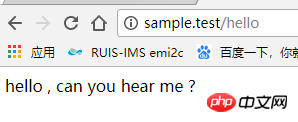
postman can also see it directly in the browser
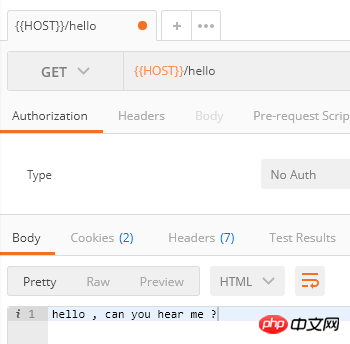
Original text:

Let’s try calling the controller first:
1 |
|
This is to directly get the request to send about, and call the about method of the StaticPagesController controller
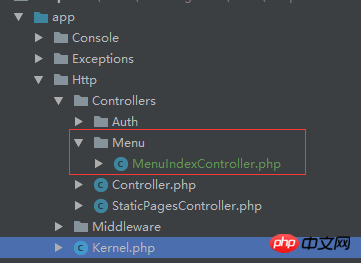
1 2 3 4 5 6 7 8 9 10 11 |
|
Jump to view:
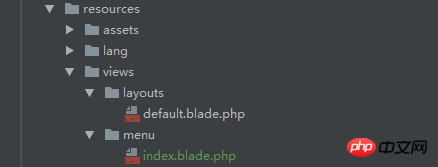
1 2 3 4 5 |
|
Browser effect:
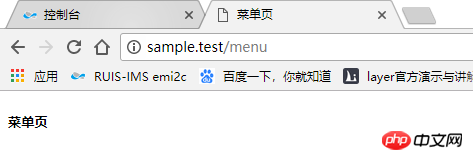
Defined in routes/ The routes in the api.php file are processed by app/Providers/RoutesServiceProvider and are nested in a routing middleware group. In this routing middleware group, all routes will be automatically added with the /api prefix, so you do not need to go to Manually add each route in the routing file. You can modify the routing prefix and other routing middleware group options by editing the RouteServiceProvider class;
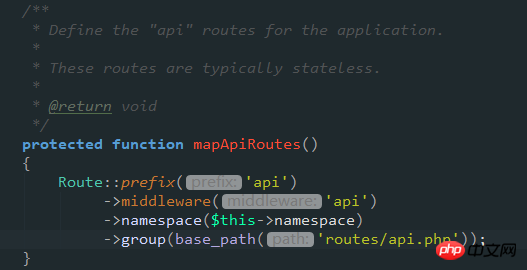
Don’t bother with this one. Changed, I don’t know what magical things will happen if the underlying things are changed;
Sometimes you need to register a route to respond to multiple HTTP request actions - this can be achieved through the match method. Alternatively, you can use the any method to register a route to respond to all HTTP request actions:
1 2 |
|
Route redirection:
If you need to define a redirect to another URI route, you can use Route::redirect
1 |
|
Enter motherfucker in the browser and you will jump to the menu;
301 is a status code, the default is 301, original text:

Of course There is also a need to jump directly to the view layer (view), and then the rest of the data (maybe whole data) is provided by the api. Then the route that jumps directly to the view is like this:
Route::view( 'staticView','static_pages/staticView');
Note that static_pages/staticView here uses forward slashes. Backslashes will cause an error saying can not found static_pages\staticView;
The static page is located at:
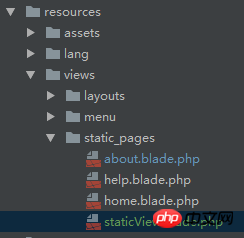
The effect of direct browser access:
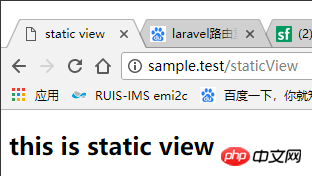
Of course there is another kind of cool operation, that is Route::view passes the third parameter, which is used for data rendering in the view
1 |
|
The array passed is naturally ['name'=>'jack','like'=>'money' ],
Usage on the page:
1 2 3 4 5 6 7 |
|
Then the browser effect:
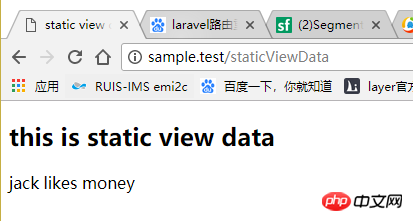
Of course you want skin, then naturally you can’t :
1 |
|
The source code will parse the tags as ordinary text, and add
before and after. The above is the entire content of this article. I hope it will be helpful to everyone's study. For more related content, please pay attention to the PHP Chinese website!
Recommended courses:
The latest laravel mall practical video tutorial
Comprehensive interpretation of the Laravel framework and practical video tutorial
The above is the detailed content of Detailed graphic and text explanation of laravel's routing (router). For more information, please follow other related articles on the PHP Chinese website!

Hot AI Tools

Undresser.AI Undress
AI-powered app for creating realistic nude photos

AI Clothes Remover
Online AI tool for removing clothes from photos.

Undress AI Tool
Undress images for free

Clothoff.io
AI clothes remover

Video Face Swap
Swap faces in any video effortlessly with our completely free AI face swap tool!

Hot Article

Hot Tools

Notepad++7.3.1
Easy-to-use and free code editor

SublimeText3 Chinese version
Chinese version, very easy to use

Zend Studio 13.0.1
Powerful PHP integrated development environment

Dreamweaver CS6
Visual web development tools

SublimeText3 Mac version
God-level code editing software (SublimeText3)

Hot Topics
 1655
1655
 14
14
 1414
1414
 52
52
 1307
1307
 25
25
 1253
1253
 29
29
 1227
1227
 24
24
 Explain JSON Web Tokens (JWT) and their use case in PHP APIs.
Apr 05, 2025 am 12:04 AM
Explain JSON Web Tokens (JWT) and their use case in PHP APIs.
Apr 05, 2025 am 12:04 AM
JWT is an open standard based on JSON, used to securely transmit information between parties, mainly for identity authentication and information exchange. 1. JWT consists of three parts: Header, Payload and Signature. 2. The working principle of JWT includes three steps: generating JWT, verifying JWT and parsing Payload. 3. When using JWT for authentication in PHP, JWT can be generated and verified, and user role and permission information can be included in advanced usage. 4. Common errors include signature verification failure, token expiration, and payload oversized. Debugging skills include using debugging tools and logging. 5. Performance optimization and best practices include using appropriate signature algorithms, setting validity periods reasonably,
 How does session hijacking work and how can you mitigate it in PHP?
Apr 06, 2025 am 12:02 AM
How does session hijacking work and how can you mitigate it in PHP?
Apr 06, 2025 am 12:02 AM
Session hijacking can be achieved through the following steps: 1. Obtain the session ID, 2. Use the session ID, 3. Keep the session active. The methods to prevent session hijacking in PHP include: 1. Use the session_regenerate_id() function to regenerate the session ID, 2. Store session data through the database, 3. Ensure that all session data is transmitted through HTTPS.
 How do you handle exceptions effectively in PHP (try, catch, finally, throw)?
Apr 05, 2025 am 12:03 AM
How do you handle exceptions effectively in PHP (try, catch, finally, throw)?
Apr 05, 2025 am 12:03 AM
In PHP, exception handling is achieved through the try, catch, finally, and throw keywords. 1) The try block surrounds the code that may throw exceptions; 2) The catch block handles exceptions; 3) Finally block ensures that the code is always executed; 4) throw is used to manually throw exceptions. These mechanisms help improve the robustness and maintainability of your code.
 Explain different error types in PHP (Notice, Warning, Fatal Error, Parse Error).
Apr 08, 2025 am 12:03 AM
Explain different error types in PHP (Notice, Warning, Fatal Error, Parse Error).
Apr 08, 2025 am 12:03 AM
There are four main error types in PHP: 1.Notice: the slightest, will not interrupt the program, such as accessing undefined variables; 2. Warning: serious than Notice, will not terminate the program, such as containing no files; 3. FatalError: the most serious, will terminate the program, such as calling no function; 4. ParseError: syntax error, will prevent the program from being executed, such as forgetting to add the end tag.
 What is the difference between include, require, include_once, require_once?
Apr 05, 2025 am 12:07 AM
What is the difference between include, require, include_once, require_once?
Apr 05, 2025 am 12:07 AM
In PHP, the difference between include, require, include_once, require_once is: 1) include generates a warning and continues to execute, 2) require generates a fatal error and stops execution, 3) include_once and require_once prevent repeated inclusions. The choice of these functions depends on the importance of the file and whether it is necessary to prevent duplicate inclusion. Rational use can improve the readability and maintainability of the code.
 PHP and Python: Comparing Two Popular Programming Languages
Apr 14, 2025 am 12:13 AM
PHP and Python: Comparing Two Popular Programming Languages
Apr 14, 2025 am 12:13 AM
PHP and Python each have their own advantages, and choose according to project requirements. 1.PHP is suitable for web development, especially for rapid development and maintenance of websites. 2. Python is suitable for data science, machine learning and artificial intelligence, with concise syntax and suitable for beginners.
 PHP: A Key Language for Web Development
Apr 13, 2025 am 12:08 AM
PHP: A Key Language for Web Development
Apr 13, 2025 am 12:08 AM
PHP is a scripting language widely used on the server side, especially suitable for web development. 1.PHP can embed HTML, process HTTP requests and responses, and supports a variety of databases. 2.PHP is used to generate dynamic web content, process form data, access databases, etc., with strong community support and open source resources. 3. PHP is an interpreted language, and the execution process includes lexical analysis, grammatical analysis, compilation and execution. 4.PHP can be combined with MySQL for advanced applications such as user registration systems. 5. When debugging PHP, you can use functions such as error_reporting() and var_dump(). 6. Optimize PHP code to use caching mechanisms, optimize database queries and use built-in functions. 7
 What are HTTP request methods (GET, POST, PUT, DELETE, etc.) and when should each be used?
Apr 09, 2025 am 12:09 AM
What are HTTP request methods (GET, POST, PUT, DELETE, etc.) and when should each be used?
Apr 09, 2025 am 12:09 AM
HTTP request methods include GET, POST, PUT and DELETE, which are used to obtain, submit, update and delete resources respectively. 1. The GET method is used to obtain resources and is suitable for read operations. 2. The POST method is used to submit data and is often used to create new resources. 3. The PUT method is used to update resources and is suitable for complete updates. 4. The DELETE method is used to delete resources and is suitable for deletion operations.



